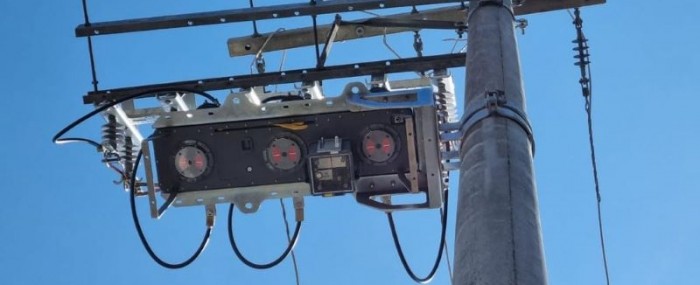
Low-cost equipment helps keep overhead power grid up and running in areas affected by wind and rain
23 de janeiro de 2024Agência FAPESP – A three-phase recloser that is more advanced and cheaper than the conventional model used by electric power utilities has been developed by engineers at HartBR, a tech startup based in Barueri, a municipality in metropolitan São Paulo, Brazil.
A recloser is a type of high-voltage switchgear designed for use on overhead electricity distribution networks. If a fault occurs when a tree lands on the power line in a storm, for example, the nearest recloser isolates the affected section of the grid and lets power be restored remotely.
To develop the innovation, HartBR’s research and development team partnered with EDP Brazil, a distribution utility for the area, and was supported by FAPESP via its Innovative Research in Small Business Program (PIPE).
“We left aside everything known about reclosers at that point in time and started from scratch on a project to develop a new model based on the needs of utilities, using the most advanced technology and introducing novel industrial concepts,” says electrical engineer Celso Garcia Lellis Júnior, founding partner of HartBR.
Located at the top of distribution poles and in substations, reclosers identify short circuits in the grid due to wind, rain, vegetation interference or other unforeseen occurrences. Once the problem has been resolved, power is automatically restored via the recloser without the need to send a technical team to the site. Recloser use is estimated to improve distribution utility service continuity indicators by 70% to 80%.
The power utilities already use reclosers, but according to Lellis Júnior, the models in place are costly and complex to produce, as well as requiring a great deal of maintenance. “They also have limitations, as they were designed on the basis of principles and technologies dating from decades ago. They can almost be considered out of date,” he said.
Conventional reclosers used sealed lead acid batteries to make sure they operate during a power outage. “These batteries have to be replaced every two years, and disposal of used batteries has to be properly managed, creating a huge logistical complication for utilities,” he said.
More than 10,000 reclosers have been installed in metropolitan São Paulo by distribution utility Enel, he added; each one has two batteries. “The utility must manage the operation and regular replacement of 20,000 batteries. Sometimes it doesn’t find out that a battery is faulty or dead until the recloser fails,” he said. Faults such as these can cause major power outages with a direct impact on supply quality indicators, leading to high maintenance and operating costs for utilities.
Conventional reclosers are also heavy, with steel components and epoxy resin for insulation and housing. A pole-mounted recloser can weigh as much as 200 kg, obliging utilities to reinforce poles in order to make sure they can bear the weight.
Another problem is lack of integration with next-generation telecommunications networks and the Internet of Things (IoT). “The conventional models communicate with command and control centers via ordinary radio,” Lellis Júnior said.
Instead of batteries, he and his engineers use supercapacitors, devices that store energy and release large amounts of it quickly, with a working life as long as the recloser itself. “These supercapacitors are charged by the grid but they have solar panels for ancillary supply, so unlike batteries they don’t have to be regularly replaced,” he said.
Weight reduction
The recloser developed by HartBR is made not of steel and resin but the type of high-strength engineering polymer used in structural applications. The polymer is low-density and neither deforms nor corrodes when exposed to high temperatures. “We worked with the manufacturer for six months to research different compositions until we achieved the right polymer for the recloser. Our product has a long working life. It is flame-retardant and withstands the action of ultraviolet radiation,” Lellis Júnior said.
The recloser has embedded communication modules for remote supervision and control via the IoT and is integrated with the supervisory control and data acquisition (SCADA) systems used by distributors to monitor the grid, saving about 80% of field crew travel and repair expenses.
According to Lellis Júnior, the first fully functional prototypes of the new recloser were presented to EDP em 2020. In December 2023, it began assembling the first batch for installation in medium-voltage (13.8 kV) overhead distribution networks.
Previously (between 2018 and 2021) HartBR developed a single-phase recloser in partnership with Energisa, another Brazilian utility. In 2022, the project culminated in the unveiling of a factory to make 250 of these reclosers per month in Atibaia (São Paulo state).
This project was funded by ANEEL, Brazil’s national electricity regulator, via its research and development program. Energisa uses the recloser in the distributors it controls, and HartBR pays royalties as a consideration for the utility’s investment in development of the product.
HartBR sells products to several distributors in Brazil and is currently exporting to Angola, Australia, Colombia, Ecuador, New Zealand and the United States.
